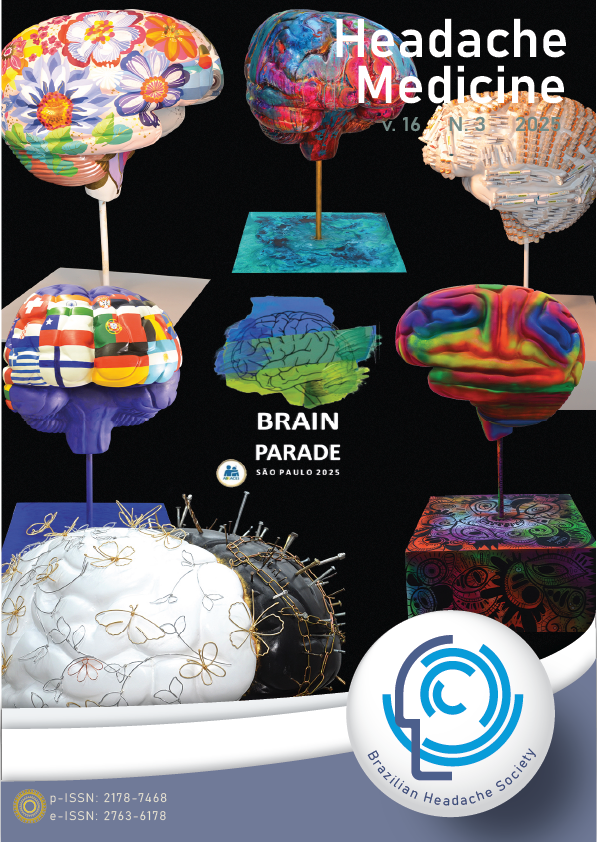“Perceiving myself small: a body volume regression to age three” — a new manifestation of Alice in Wonderland Syndrome in a migraine patient
Views: 73DOI:
https://doi.org/10.48208/HeadacheMed.2025.28Keywords:
Alice in Wonderland Syndrome, Migraine, Aura, MicrosomatognosiaAbstract
Introduction
Alice in Wonderland Syndrome (AIWS) is a rare neurological condition often associated with migraine and characterized by perceptual distortions of body image, time, and space.
Case report
We report the case of a 33-year-old woman with a history of migraine since adolescence who presented with recurrent episodes of AIWS. During severe migraine attacks, she experienced microsomatognosia, perceiving her body as shrinking to the size of a child when her eyes were closed, along with temporal distortion described as “slow motion” of her surroundings. Neurological examination, brain MRI, and angiography were unremarkable. Despite prophylactic therapy with topiramate and acute treatment with triptans, disabling attacks persisted.
Conclusion
This case highlights the complex relationship between migraine and AIWS, reinforcing the need for clinicians to recognize AIWS manifestations as part of the migraine spectrum. Early identification can prevent misdiagnosis and improve patient management.
Downloads
References
Ilik F, Ilik K. Alice in Wonderland syndrome as aura of migraine. Neurocase 2014;20:474–5. Doi:10.1080/13554794.2013.826676. DOI: https://doi.org/10.1080/13554794.2013.826676
Blom JD. Alice in Wonderland syndrome. Neurol Clin Pract 2016;6:259–70. Doi:10.1212/CPJ.0000000000000251. DOI: https://doi.org/10.1212/CPJ.0000000000000251
Sanvito WL. Alice in Wonderland Syndrome. Headache Medicine 2019;10:41–2. Doi:10.48208/HeadacheMed.2019.12. DOI: https://doi.org/10.48208/HeadacheMed.2019.12
Brooks JBB, Prosdocimi FC, Rosa PB da, Fragoso YD. Alice in Wonderland syndrome: “Who in the world am I?” Arq Neuropsiquiatr 2019;77:672–4. Doi:10.1590/0004-282x20190094. DOI: https://doi.org/10.1590/0004-282x20190094
Mastria G, Mancini V, Viganò A, De Sanctis R, Letteri F, Toscano M, et al. Temporal–occipital glioblastoma presenting with Alice in Wonderland Syndrome in a patient with a long-time history of migraine without aura. Neurocase 2018;24:242–4. Doi:10.1080/13554794.2018.1562079. DOI: https://doi.org/10.1080/13554794.2018.1562079
Almeida LCA, Valença MM. “Um mundo em câmera lenta” como manifestação da Síndrome de Alice no País das Maravilhas: um relato de caso. Headache Medicine 2017:134–7. Doi:10.48208/HeadacheMed.2017.21. DOI: https://doi.org/10.48208/HeadacheMed.2017.21
Valença MM. Migraine and the feeling that “the world is in slow motion.” Headache Medicine 2017:116–9. Doi:10.48208/HeadacheMed.2017.17. DOI: https://doi.org/10.48208/HeadacheMed.2017.17
Tanrıverdi Ç, Kara İ. A CASE OF MIGRAINE WITH SYMPTOMS OF PERCEPTION DISORDERS INCLUDING A FAMILY HISTORY. Neurocase 2022;28:181–4. Doi:10.1080/13554794.2022.2051560. DOI: https://doi.org/10.1080/13554794.2022.2051560
Hernandez J. The Mental Health Syndrome Known as Alice in Wonderland - A Case Report. Int Neuropsychiatr Dis J 2022:43–7. Doi:10.9734/indj/2022/v18i1344. DOI: https://doi.org/10.9734/indj/2022/v18i1344
Staccioli S, Mariani R, Bompard S, Olivini N, Fanfoni C, Mirra G, et al. Alice in Wonderland Syndrome in Children With Severe Acute Respiratory Syndrome SARS-CoV-2 Infection: A Case Series of Two Patients in an Italian Hospital. Pediatr Neurol 2025;162:28–31. Doi:10.1016/j.pediatrneurol.2024.10.008. DOI: https://doi.org/10.1016/j.pediatrneurol.2024.10.008
Biggi M, Contento M, Magliani M, Giovannelli G, Barilaro A, Bessi V, et al. Alice in wonderland syndrome “through the looking-glass” in a rare presentation of non-convulsive status epilepticus in cerebral venous sinus thrombosis and COVID-19. Cortex 2023;167:218–22. Doi:10.1016/j.cortex.2023.06.020. DOI: https://doi.org/10.1016/j.cortex.2023.06.020
Smith RA, Wright B, Bennett S. Hallucinations and illusions in migraine in children and the Alice in Wonderland Syndrome. Arch Dis Child 2015;100:296–8. Doi:10.1136/archdischild-2013-305283. DOI: https://doi.org/10.1136/archdischild-2013-305283
Vilela M, Fernandes D, Salazar T, Maio C, Duarte A. When Alice Took Sertraline: A Case of Sertraline-Induced Alice in Wonderland Syndrome. Cureus 2020. Doi:10.7759/cureus.10140. DOI: https://doi.org/10.7759/cureus.10140
Jiang WX, Leung JG, Carlson DN, Staab JP. A case of Alice in Wonderland Syndrome associated with topiramate in a patient with vestibular migraine. Mental Health Clinician 2025;15:208–13. Doi:10.9740/mhc.2025.08.208. DOI: https://doi.org/10.9740/mhc.2025.08.208
Mastria G, Mancini V, Cesare M Di, Puma M, Alessiani M, Petolicchio B, et al. Prevalence and characteristics of Alice in Wonderland Syndrome in adult migraineurs: Perspectives from a tertiary referral headache unit. Cephalalgia 2021;41:515–24. Doi:10.1177/0333102420968245. DOI: https://doi.org/10.1177/0333102420968245
Fitzek MP, Mecklenburg J, Overeem LH, Lange KS, Siebert A, Triller P, et al. Alice in Wonderland Syndrome (AIWS): prevalence and characteristics in adults with migraine. J Neurol 2024;271:5146–55. Doi:10.1007/s00415-024-12471-5. DOI: https://doi.org/10.1007/s00415-024-12471-5
Chirchiglia D, Chirchiglia P, Marotta R. A singular association of migraine with brainstem aura and Alice in Wonderland syndrome. Child’s Nervous System 2019;35:1435–7. Doi:10.1007/s00381-019-04170-8. DOI: https://doi.org/10.1007/s00381-019-04170-8
Beh SC, Masrour S, Smith S V., Friedman DI. Clinical characteristics of Alice in Wonderland syndrome in a cohort with vestibular migraine. Neurol Clin Pract 2018;8:389–96. Doi:10.1212/CPJ.0000000000000518. DOI: https://doi.org/10.1212/CPJ.0000000000000518
Mastria G, Mancini V, Viganò A, Piervincenzi C, Petsas N, Puma M, et al. Neural fingerprints of Alice in Wonderland Syndrome in patients with migraine with aura 2022. Doi:10.1101/2022.06.20.22276604. DOI: https://doi.org/10.1101/2022.06.20.22276604
Mastria G, Mancini V, Viganò A, Piervincenzi C, Petsas N, Puma M, et al. Neuroimaging markers of Alice in Wonderland syndrome in patients with migraine with aura. Front Neurol 2023;14. Doi:10.3389/fneur.2023.1210811. DOI: https://doi.org/10.3389/fneur.2023.1210811
Uca AU, Kozak HH. The Alice in Wonderland Syndrome: A Case of Aura Accompanying Cluster Headache. Balkan Med J 2015;32:320–2. Doi:10.5152/balkanmedj.2015.15650. DOI: https://doi.org/10.5152/balkanmedj.2015.15650
The International Classification of Headache Disorders, 3rd edition (beta version). Cephalalgia 2013;33:629–808. Doi:10.1177/0333102413485658. DOI: https://doi.org/10.1177/0333102413485658
Evans RW. Reversible Palinopsia and the Alice in Wonderland Syndrome Associated With Topiramate Use in Migraineurs. Headache: The Journal of Head and Face Pain 2006;46:815–8. Doi: 10.1111/j.1526-4610.2006.00458_1.x. DOI: https://doi.org/10.1111/j.1526-4610.2006.00458_1.x
Jurgens TP, Ihle K, Stork J-H, May A. “Alice in Wonderland syndrome” associated with topiramate for migraine prevention. J Neurol Neurosurg Psychiatry 2011;82:228–9. Doi: 10.1590/s0004-282x2012000300017. DOI: https://doi.org/10.1136/jnnp.2009.187245
Downloads
Published
How to Cite
Issue
Section
License
Copyright (c) 2025 Marcelo Moraes Valença, Rita Santana dos Reis, Juliana Ramos de Andrade (Author)

This work is licensed under a Creative Commons Attribution 4.0 International License.













